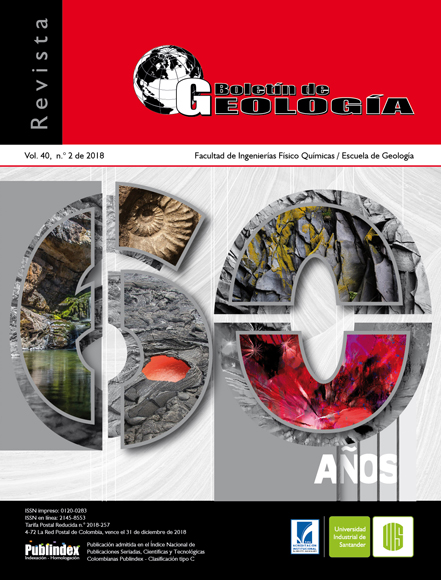3D seismic tomography in the seismic nest of Bucaramanga (Colombia)
Published 2018-06-05
Keywords
- seismic tomography,
- Seismic Nest of Bucaramanga,
- velocity model
How to Cite
Altmetrics
Abstract
Seismic tomography is a set of techniques used to obtain an image of velocity filds inside the Earth, using waves measurements. In this work, this technique was used to generate a quasi-3D velocity model of the P wave of Bucaramanga’s nest zone –a highly seismic zone in Colombia caused by the collision of the Caribbean and Nazca Plates under the South American plate, able to generate intermediate earthquakes (70 – 200km). For this research, 1223 earthquakes recorded by the seismic stations of “National Seismological Network of Colombia” were analyzed. They all occurred in Santander, Colombia, within 6° - 8°N and 72° - 74°W recorded from January 2012 to June 2016. Only 1138 events that met the seismic nest parameters –like latitude, longitude and depth – were used to generate a fist 1D velocity model where only depth velocity variations were considered. Furthermore, a quasi-3D model with both horizontal layers of different depths and lateral variations was generated. Results show two continuous anomalies in the study zone: the first one, a negative one interpreted as partial melt of magma and, the second one, a positive anomaly interpreted to magma crystallization.
Downloads
References
Aki, K., and Lee, H.K. (1976). Determination of three-dimensional velocity anomalies under a seismic array using fist P arrival times from local earthquakes: 1. A homogeneous initial model. Journal of Geophysical Research: Solid Earth and Planets, 81(23), 4381-4399. doi: 10.1029/JB081i023p04381.
Aki, K., and Richards, P.G. (1980). Quantitative seismology, theory and methods. Vol. 1. New York: W.H.Freeman & Co Ltd.
Anderson, D.L., Schreiber, E., Liebermann, C., and Soga, N. (1968). Some elastic constant data on minerals relevant to geophysics. Reviews of Geophysics, 6(4), 491-524. doi: 10.1029/RG006i004p00491.
Aster, R., Borchers, B., and Thurber, C. (2013). Parameter estimation and inverse problems. 2nd Edition. Amsterdám: ElSevier Academic Press.
Birch, F. (1960). The velocity of compressional waves in rocks to 10 kilobars: 1. Journal of Geophysical Research, 65(4), 1083-1102.
Coral-Gómez, C.E. (1990). La convergencia de placas en el Noroccidente Suramericano y el origen del nido sísmico de Bucaramanga. Revista Académica Colombiana de Ciencias Exactas, Físicas y Naturales, 17(66), 521-529.
Crosson, R.S. (1976). Crustal structure modeling of earthquake data, I, Simultaneous least squares estimation of hypocenter and velocity parameters. Journal Geophysical Research, 81(17), 3036-3046. doi: 10.1029/JB081i017p03036.
Gómez-Padilla, J. (1980). Actividad sísmica en el departamento de Santander. Boletín de Geología, 14(28), 3-23.
Havskov, J., and Ottemoller, L. (1999). SeisAn earthquake analysis software. Seismological Research Letter, 70(5), 532-534. doi: 10.1785/gssrl.70.5.532.
Kissling, E. (1988). Geotomography with local earthquake data. Review of Geophysics, 26(4), 659-698. doi: 10.1029/RG026i004p00659.
Kissling, E., Ellsworth, W.L., Eberhart-Phillips, D., and Kradolfer, U. (1994). Initial reference model in local earthquake tomography. Journal of Geophysical Research: Solid Earth, 99(B10), 19635-19646. doi: 10.1029/93JB03138.
Londoño, J.M., Bohorquez, O.P., and Ospina, L.F. (2010). Tomografía sísmica 3D del sector de Cúcuta, Colombia. Boletín de Geología, 32(1), 107-124.
Pennington, W.D. (1981). Subduction of the eastern Panama basin and sismo tectonics of northwestern South America. Journal of Geophysical Research, 86(B11), 10753-10770.
Pennington, W.D., Mooney, W.D., Van Hissenhovenet, R., Meyer, H., Ramírez, J.E., and Meyer, R.P. (1981). Resultado de un estudio de microsismos en Bucaramanga, Colombia. En: Investigaciones geofísicas sobre las estructuras océanocontinentales del Occidente Colombiano (pp. 42-64). Proyecto Nariño II y III. Bogotá.
Pennington, W.D. (1983). Role of shallow phase changes in the subduction of oceanic crust. Science, 220(4601), 1045-1047. doi: 10.1126/science.220.4601.1045.
Perico-Martínez, N.R., y Perico-Granados, N.R. (2014). Caracterización y recurrencia sísmica del nido de Bucaramanga. V Congreso Internacional de Ingeniería Civil. Universidad Santo Tomás, Tunja, Colombia.
Prieto, G.A., Beroza, G.C., Barrett, S.A, López, G.A., and Flórez, M. (2012). Earthquake nests as natural laboratories for the study of intermediate-depth earthquake mechanics. Tectonophysics, 570-571, 42-56.
Ramírez, J.E. (1969). Historia de los terremotos en Colombia. Bogotá: Instituto Geográfio Agustin Codazzi.
Rivera, A. (1989). Inversion du tenseur des constraintes et des mécanismes au foyer a partir des données de polarités pour une population de seísmes. Application a l’Ecude du foyer de seismicite intermeiate de Bucaramanga – Colombia. Tésis de Doctorado. Universite Louis – Pasteur de Strasburg. 266p.
Salcedo, E.J. (1999). Estudio de sismicidad histórica en la región de Bucaramanga (Colombia). Revista de la Academia Colombiana de Ciencias, Exactas, Físicas y Naturales, 23(87), 233-248.
Schneider, J.F., Pennington, W.D., and Meyer, R.P. (1987). Microseismicity and focal mechanisms of the intermediate-depth Bucaramanga Nest, Colombia. Journal of Geophysical Research, 92(B13), 13913-13926.
Stein, S., and Wysession, M. (2003). An introduction to seismology, earthquakes, and earth structure. MA, USA: Blackwell Publishing.
Strang, G. (2009). Introduction to linear algebra. 4th Edition. MA, USA: Wellesley Cambridge Press.
Thurber, C.H. (1981). Earth structure and earthquake locations in the Coyote Lake area, central California. Ph.D. Thesis, Massachusetts Institute of Technology, USA.
Thurber, C.H. (1992). Hypocenter-velocity structure coupling in local earthquake tomography. Physics of the Earth and Planetary Interiors, 75(1-3), 55-62. doi: 10.1016/0031-9201(92)90117-E.
Tryggvason, E., and Lawson, J.E., Jr. (1970). The intermediate earthquake source near Bucaramanga, Colombia. Bullentin of the Seismological Society of America, 60(1), 269-279.
Van der Hilst, R., and Mann, P. (1994). Tectonic implication of tomographic images of subducted lithosphere beneath northwestern South America. Geology, 22, 451-454.
Van Keken, P.E. (2003). The structure and dynamics of the mantle wedge. Earth and Planetary Science Letters, 215(3-4), 323-338. doi: 10.1016/S0012-821X(03)00460-6.
Vargas, C.A., Pujades, L.G., Ugalde, A., y Canas, J.A. (2003). Tomografía sísmica local en el territorio colombiano. Revista Internacional de Métodos Numéricos para Cálculo y Diseño de Ingeniería, 19(3), 255-278.
Zarifi Z., and Havskov, J. (2003). Characteristics of dense nests of deep and intermediate depth seismicity. Advances in Geophysics, 46, 237-278.
Zarifi Z., Havskov, J., and Hanyga, A. (2007). An insight into the Bucaramanga nest. Tectonophysics, 443(1-2), 93-105. doi: 10.1016/j.tecto.2007.06.004.

